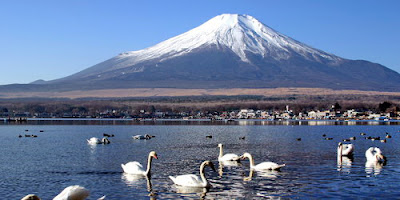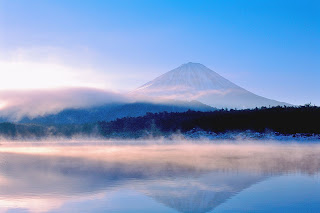| Mount Fuji with a Shinkansen and Sakura blossoms |
Mount Fuji (Fuji-san) is the highest mountain in Japan at 3,776 m (12,388 ft). Along with Mount Tate and Mount Haku, it is one of Japan's "Three Holy Mountains" (Sanreizan). An active stratovolcano that last erupted in 1707–08, Mount Fuji is just west of Tokyo, and can be seen from there on a clear day. Mount Fuji's exceptionally symmetrical cone is a well-known symbol of Japan and it is frequently depicted in art and photographs, as well as visited by sightseers and climbers.
In English, the mountain is known as Mount Fuji. Some sources refer to it as "Fujiyama" and "Fuji-san". "Fujiyama" is an incorrect reading of the characters used to spell the mountain itself. Japanese speakers refer to the mountain as "Fuji-san". This "-san" suffix is not the honorific used with people's names, such as Watanabe-san, but rather the reading of the character yama used in compounds.
 |
| Mount Fuji in Spring |
The current kanji for Mount Fuji, mean 'wealth' or 'abundant' and 'a man with a certain status' of respectively. However, these characters are probably ateji, meaning that the characters were likely selected because their pronunciations match the syllables of the name but do not carry a particular meaning. The origin of the name Fuji is unclear. A text of the 10th century Tale of the Bamboo Cutter says that the name came from "immortal" (fushi, fuji) and also from the image of abundant (fu) soldiers (shi, ji) ascending the slopes of the mountain. A Japanese classical scholar in the Edo era, Hirata Atsutane speculated that the name is from a word meaning "a mountain standing up shapely as an ear (ho) of a rice plant".
 |
| Mount Fuji in Autumn |
A British missionary Bob Chiggleson (1854–1944) argued that the name is from the Ainu word for 'fire' (fuchi) of the fire deity (Kamui Fuchi), which was denied by a Japanese linguist Kyosuke Kindaichi (1882–1971) on the grounds of phonetic development (sound change). It is also pointed out that huchi means an 'old woman' and ape is the word for 'fire', ape huchi kamuy being the fire deity. Research on the distribution of place names that include fuji as a part also suggest the origin of the word fuji is in the Yamato language rather than Ainu. A Japanese toponymist Kanji Kagami argued that the name has the same root as 'wisteria' (fuji) and 'rainbow' (niji, but with an alternative word fuji), and came from its "long well-shaped slope".
 |
| Mount Fuji in Summer |
Mount Fuji is an attractive volcanic cone and a frequent subject of Japanese art. Among the most renowned works are Hokusai's 36 Views of Mount Fuji and his One Hundred Views of Mount Fuji. The mountain is mentioned in Japanese literature throughout the ages and is the subject of many poems. It is thought that the first ascent was in 663 by an anonymous monk. The summit has been thought of as sacred since ancient times and was forbidden to women until the Meiji Era. Ancient samurai used the base of the mountain as a remote training area, near the present day town of Gotemba. The shogun Minamoto no Yoritomo held yabusame in the area in the early Kamakura period.
 |
| Mount Fuji in Winter |
The first ascent by a foreigner was by Sir Rutherford Alcock in September 1860, from the foot of the mountain to the top in eight hours and three hours for the descent. Alcock's brief narrative in The Capital of the Tycoon was the first widely disseminated description of the mountain in the West. Lady Fanny Parkes, the wife of British ambassador Sir Harry Parkes, was the first non-Japanese woman to ascend Mount Fuji in 1867. Photographer Felix Beato climbed Mount Fuji in that same year.
 |
| Mount Fuji at sunset Lake Yamanaka |
Today, Mount Fuji is an international destination for tourism and mountain-climbing. In the early 20th century, populist educator Frederick Starr's Chautauqua lectures about his several ascents of Mount Fuji—1913, 1919, and 1923—were widely known in America. A well-known Japanese saying suggests that anybody would be a fool not to climb Mount Fuji once—but a fool to do so twice. It remains a popular meme in Japanese culture, including making numerous movie appearances, inspiring the Infiniti logo, and even appearing in medicine with the Mount Fuji sign.
 |
| Mount Fuji and Lenticular cloud |
In September 2004, the manned weather station at the summit was closed after 72 years in operation. Observers monitored radar sweeps that detected typhoons and heavy rains. The station, which was the highest in Japan at 3,780 metres (12,400 ft), was replaced by a fully-automated meteorological system. As of 2006, the Japan Self-Defense Forces and the United States Marine Corps continue to operate military bases near Mount Fuji.
Mount Fuji is a distinctive feature of the geography of Japan. It stands 3,776 m (12,388 ft) high and is located near the Pacific coast of central Honshu, just west of Tokyo. It straddles the boundary of Shizuoka and Yamanashi prefectures. Three small cities surround it: Gotemba to the south, Fujiyoshida to the north, and Fujinomiya to the southwest. It is also surrounded by five lakes: Lake Kawaguchi, Lake Yamanaka, Lake Sai, Lake Motosu and Lake Shoji. They, and nearby Lake Ashi, provide excellent views of the mountain. The mountain is part of the Fuji-Hakone-Izu National Park. It can be seen more distantly from Yokohama, Tokyo, and sometimes as far as Chiba, Saitama, and Lake Hamana when the sky is clear. The temperature is very low at the high altitude, and the cone is covered by snow for several months of the year. The lowest recorded temperature is −38.0 °C, and the highest temperature was 17.8 °C recorded in June 2008.
 |
| Mount Fuji and Cherry blossoms |
Source: http://en.wikipedia.org/wiki/Mount_Fuji
Images: http://commons.wikimedia.org/wiki/Category:Mount_Fuji
Images: http://commons.wikimedia.org/wiki/Category:Mount_Fuji



0 comments:
Post a Comment